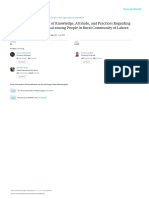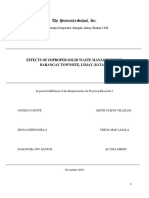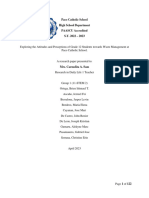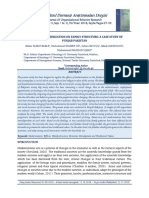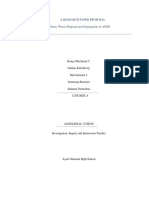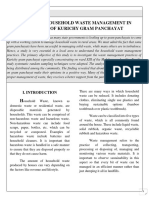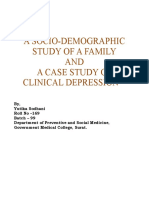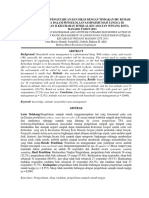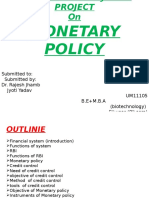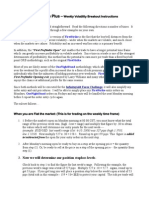Professional Documents
Culture Documents
Assessment of Knowledge, Attitude and Practice of Segregation and Disposal of Solid Waste at Household Level in A Suburban Area of Chennai
0 ratings0% found this document useful (0 votes)
30 views3 pages Introduction
Solid waste is a by product of human activities.
These can be classified according to their use their
physical nature and their composition. Due to
urbanization and changing lifestyles and increase in
human population, this has lead to rapid generation of
human solid wastes. The government although
responsible for this cannot do this altogether because of
lack of infrastructure. So in many countries people
have started participating in the segregation of wastes.
Original Title
Assessment of Knowledge, Attitude and Practice of Segregation and Disposal of Solid Waste at Household Level in a Suburban Area of Chennai
Copyright
© © All Rights Reserved
Available Formats
PDF, TXT or read online from Scribd
Share this document
Did you find this document useful?
Is this content inappropriate?
Report this Document Introduction
Solid waste is a by product of human activities.
These can be classified according to their use their
physical nature and their composition. Due to
urbanization and changing lifestyles and increase in
human population, this has lead to rapid generation of
human solid wastes. The government although
responsible for this cannot do this altogether because of
lack of infrastructure. So in many countries people
have started participating in the segregation of wastes.
Copyright:
© All Rights Reserved
Available Formats
Download as PDF, TXT or read online from Scribd
0 ratings0% found this document useful (0 votes)
30 views3 pagesAssessment of Knowledge, Attitude and Practice of Segregation and Disposal of Solid Waste at Household Level in A Suburban Area of Chennai
Introduction
Solid waste is a by product of human activities.
These can be classified according to their use their
physical nature and their composition. Due to
urbanization and changing lifestyles and increase in
human population, this has lead to rapid generation of
human solid wastes. The government although
responsible for this cannot do this altogether because of
lack of infrastructure. So in many countries people
have started participating in the segregation of wastes.
Copyright:
© All Rights Reserved
Available Formats
Download as PDF, TXT or read online from Scribd
You are on page 1of 3
Volume 4, Issue 8, August – 2019 International Journal of Innovative Science and Research Technology
ISSN No:-2456-2165
Assessment of Knowledge, Attitude and Practice
of Segregation and Disposal of Solid Waste at
Household Level in a Suburban Area of Chennai
Author : Kesav Narayan.S
Coauthor : Dr. Alice Matilda Mendez
Department Of Community Medicine Saveetha Medical Collage
Abstract:- I. INTRODUCTION
Introduction The product of human and animal activities results in
Solid waste is a by product of human activities. the generation of solid waste (1). These can be classified in
These can be classified according to their use their terms of their original use, the material, their physical
physical nature and their composition. Due to properties, their origin and safety parameters. Due to
urbanization and changing lifestyles and increase in urbanization and the increasing standards of the modern
human population, this has lead to rapid generation of people and a rise in the population have led to increased
human solid wastes. The government although generation of solid wastes in the environment. The total
responsible for this cannot do this altogether because of municipal solid wastes generated in urban india alone has
lack of infrastructure. So in many countries people been estimated to be 64 million tons per year (2). In india an
have started participating in the segregation of wastes. individual produces an average of 0.8kg/waste/person
daily(3). So this has led to a most challenging problem in
Aim and Objective the today’sworld. The government however who is
To assess the knowledge attitude and practice of responsible for this situation due to lack of infrastructure
segregation and disposal of solid wastes at the and financial hardships can’t do this alone altogether. So
household level and perceived impact of plastic ban on in many countries the community have participated and
the society in a suburban township in Chennai made a drastic change in the process of disposing the solid
wastes even starting at the household level. Even for
Materials and Methods recycling the wastes the process of separation has to be
A cross sectional study was conducted among the done.
households of suburban population in Avadi municipal
area. 10 out of 48 wards of Avadi were randomly The purpose of this research is to access the
selected and 30 households from each ward were knowledge, attitude and practise of the households in
included in the study. Data was collected by segregation and disposal of the wastes at their level and
interviewing the head of family using a structured also the knowledge and practise of recycling. This study
questionnaire. Data was entered in MS excel and was looks at the characteristics that are related to waste
analysed. separation activities. Another important objective of this
study is to know the awareness of the plastic ban on the
Results lives of the people and whether they accept this current ban
From the study 63% of the head of the family had and also thinks that the current plan would benefit for the
higher education(above 12 grade) . 33% were betterment of the society.
professionals. 95% lived in a nuclear family. 99% had
good knowledge on the segregation and disposal of II. METHODOLOGY
wastes. 90% gained the knowledge of segregation of
wastes at the household level from the social media. A cross sectional study was done from march 2019 to
But only 66% of them has a good practice score. Among June 2019. The study area is AVADI(municipal area) with
those who practised, 80% had the practise of a area of 39km 2 with a population of 345,996.It has
segregation of the wastes in different coloured bins. totally 48 wards. The data for the study was collected from
36% had practise of preparing manure pit. 21% of the 300 households in AVADI. According to the formula
people burn plastics. 74% of the people were aware of 4pq/l2 where p = 51.3 , q= 100-p and l= 20% of p the
the plastic ban . sample size is 150. From reference [4]. The sampling effect
is 2 , so the final sample size was 300. Cluster sampling
Conclusion was done and 6 wards out of the 48 wards were selected
The study clearly depicts that even though the randomly and out of that 6 wards 50 houses were selected
people had knowledge on segregation of the wastes randomly by applying PROBABLITY PROPOTIONAL
many did not practice the segregation of the wastes. SIZE (PPS) . A structured questionnaire was used to collect
the information. The questionnaire was designed in such a
IJISRT19AUG948 www.ijisrt.com 731
Volume 4, Issue 8, August – 2019 International Journal of Innovative Science and Research Technology
ISSN No:-2456-2165
way as it covered questions related to knowledge such as -
have you heard about the term segregation and do you and Education of head of Frequency(n=300) Percentage
your family members have a knowledge about the bio and family
non biodegradable wastes. Attitude questions such as- do Primary 14 4.6%
you feel that streets should be clean and free of solid wastes Secondary 102 34%
and - have you ever thought of solid waste segregation at Higher 184 61.3%
home. Practise questions such as - do you burn the plastics , Type of family
do you practise segregation of the wastes. And questions on Nuclear 286 95.5%
the awareness of the plastic ban such as are you aware of Joint 14 4.7%
this plan and are you happy with is action. And also the Occupation
questionnaire had some basic demographic questions. All Professional 100 33.3%
individuals who took part in this study were included and Sem iprofessional 50 16.7%
those who were not willing to take part were excluded. A Skilled 60 20%
set of questions were used to assess the knowledge, attitude unskilled 80 26.6%
and practice and scores were awarded to each household. Table 1:- Basic Demographic Details
III. RESULTS
Frequency(n=300) Percentage
Knowledge
A total of 300 households were included in the study.
Good 297 99%
The demographic and sociodemographic profile of the
Intermediate 2 0.5%
study population from table 1 shows that among the 300
Low 1 0.5%
households 61% had higher education(12 grade and above)
95% of the people lived in nuclear family and only 5% of
Attitude score
the people lived in joint family. 100 out of 300 people
Good 140 46.6%
about 33% were professionals. This depicts the good
Intermediate 152 50.67%
education status of the locality. 98% of the people had the
Low 8 2.6%
knowledge of segregation of the household wastes from
social media and only 2% of the people from other sources. Practice score
Good 198 66%
As the purpose of the study is to assess the knowledge Intermediate 67 22.33%
attitude and practice of segregation and disposal of wastes Low 35 11.6%
at the household level separate scores were given each to Table 2:- Level of knowledge, attitude and practice
knowledge attitude and practice. 6 questions in each regarding solid waste disposal
knowledge attitude and practice were taken for awarding
the scores. The scores were entered in ms excel and Frequency Percentage
analysed. Good corresponds to 6, intermediate corresponds Practice Segregation
to 5 and 4 and poor score corresponds to 3 and below. of wastes 290 96.6%
Every household was taken as a unit and the scores were Yes 10 3.2%
awarded. No
Do you segregate in
99% of the people had good knowledge about the different bins 242 80.6%
segregation and disposal of the wastes which is seen from Yes 58 19.4%
the table 2. It is seen from table 2 that the practice and No
attitude scores were less when compared to their Come and collect
knowledge. This clearly depicts that the people of the waste 227 75.6%
locality even though they have good knowledge they aren’t Yes 73 24.33%
practicing the segregation and disposal of the household No
wastes. Do you Prepare
manure pit 108 36%
36% of the people prepare manure pit in their homes Yes 192 64%
as depicted from the table 3.This idea of manure pit reduces No
the amount of the solid waste generated and also this would Do you Burn plastics
serve as a manure for the plants grown in their homes. 28 % Yes 85 28.3%
of the people burn plastics which is not good for the No 215 71.67%
environment. Do you sell old
bottles to scrap 84 28%
A separate set of questions were asked to know the Yes 216 72%
awareness of plastic ban which was implemented in the No
current year 2019. 224 out of the 300 households did not Table 3:- Practice of solid waste disposal in households
face any difficulty in their daily lives do the
implementation of the plastic ban.
IJISRT19AUG948 www.ijisrt.com 732
Volume 4, Issue 8, August – 2019 International Journal of Innovative Science and Research Technology
ISSN No:-2456-2165
Frequency Percentage [4]. Dr Jagna Trivedi etal, A study on household
Aware of this ban management practices in Gandhinagar city , NMIMS
Yes 222 74% Management Review Volume XXVII April-May 2015
No 78 26% ISSN: 0971-1023
Difficulties in your [5]. MH Ehrampoush, MH Baghiani Moghadam, Survey
daily lives 76 25.33% of knowledge, attitude and practices of yazad
Yes 224 75.7% university of medical sciences students about solid
No waste disposal and recycling , Journal of
Table 4:- Awareness of plastic ban Environmental Health Science & Engineering 2005.
2(2):26-
IV. DISCUSSION [6]. CD Licy, R Vivek etal , Awareness, attitude and
practices of school students towards household waste
From this study we have accessed the attitude, management , Vivek et al / Journal of Environment
knowledge and practice of segregation and disposal of (2013), Vol. 02, Issue 06, pp. 147-150
wastes at the household level. Many had the knowledge [7]. Electrical and electronic waste management practices
about the segregation of the wastes from social media. This by household in shah alam malasia JA kalana-
is similar the study done in Gandhi nagar (4). Also from the international journal of environmental sciences, 2010-
reference articles and comparing the results (4,5,6), the people indiajournals.com
of this locality had more knowledge about the waste [8]. Suwarna Madhukumar, Ramesh G, Study about
segregation. This is very high when compared to other awareness and practices about health care waste
studies(5) may be this is due to their level of education very management among hospital staff in a medical college
high.(64% higher education). According to this study many hospital management banglore ,int journal of basic
had knowledge but did not practice the segregation of medical sciences, April 2012, Vol : 3, Issue : 1
wastes which is similar to the study done by C.D Lincy etal [9]. Awareness, knowledge and practices on bio- medical
(6)
. Many had awareness about the plastic ban from this waste management among health care professionals in
year and many gave a welcoming response to that action. manglore A cross sectional study F pullishery, GS
They too said that the plastic ban didn’t have any major panchmal, S Siddique, A Abraham IAIM, 2016-
difficulty in their lives. researchgate.net
V. CONCLUSION
The study thus concludes that the household of the
AVADI municipal corporation has a good education
profile. The people of the locality have good knowledge
about the segregation and disposal of the wastes. But
compared to their knowledge their practice was less as it
was depicted by the practice score as compared to their
knowledge score. About 36% have the habit of preparing
manure pit in their homes. The people of the locality were
aware of the plastic ban which was implemented in the year
2019. About 75% of the people of the locality did not face
any difficulty in their daily lives due to the plastic ban.
REFRENCES
[1]. Banga, Margaret, "Household Knowledge, Attitudes
and Practices in Solid Waste Segregation and
Recycling: The Case of Urban Kampala," Zambia
Social Science Journal: 2011, Vol. 2 : No. 1 , Article
4.
Available at:
https://scholarship.law.cornell.edu/zssj/vol2/iss1/4
[2]. Tapas Kumar Ghatak, Municipal Solid Waste
Management in India: A Few Unaddressed Issues,
Procedia Environmental Sciences, Volume 35, 2016,
pp. 169-175
[3]. India Water Portal ,2019; Safe, sustainable water for
all https://www.indiawaterportal.org/
IJISRT19AUG948 www.ijisrt.com 733
You might also like
- Evaluate The Impact of Interventions On Household Waste Disposal Knowledge and Practices Among Women at Selected Villages of Mohali, PunjabDocument5 pagesEvaluate The Impact of Interventions On Household Waste Disposal Knowledge and Practices Among Women at Selected Villages of Mohali, PunjabEditor IJTSRDNo ratings yet
- Determination The Level of Knowledge, Attitude, and Practices Regarding Household Waste Disposal Among People in Rural Community of LahoreDocument7 pagesDetermination The Level of Knowledge, Attitude, and Practices Regarding Household Waste Disposal Among People in Rural Community of LahoreYusmanidarNo ratings yet
- Hands On Research With The Residents and Authorities in A Community A Study On The Solid Waste ManagDocument7 pagesHands On Research With The Residents and Authorities in A Community A Study On The Solid Waste ManagAlyzzaNo ratings yet
- Chu 2019Document6 pagesChu 2019Edgar Uriel Rodriguez MuñozNo ratings yet
- Review of Related LiteratureDocument7 pagesReview of Related Literaturemark3dasaNo ratings yet
- Practical Research 1Document15 pagesPractical Research 1ShellaNo ratings yet
- Thesis PaperDocument26 pagesThesis Paperkyla100% (2)
- RESEARCH-para-print-chapter-1-and-2-final-konohay - Solid Waste ManagementDocument29 pagesRESEARCH-para-print-chapter-1-and-2-final-konohay - Solid Waste ManagementAlan VillegasNo ratings yet
- Research Paper DraftDocument122 pagesResearch Paper DraftLois MendozaNo ratings yet
- Waste Management Practices Among Inhabitant's of Kanuru Panchayath, Penamaluru Mandal in Vijayawada, AndhrapradeshDocument2 pagesWaste Management Practices Among Inhabitant's of Kanuru Panchayath, Penamaluru Mandal in Vijayawada, AndhrapradeshInternational Journal of Innovative Science and Research TechnologyNo ratings yet
- For Research DefenseDocument15 pagesFor Research Defensesandejoalfrancis7No ratings yet
- Pedal-Powered Leaf Shredder Converts Leaves to MulchDocument35 pagesPedal-Powered Leaf Shredder Converts Leaves to MulchMa. Alyzandra G. LopezNo ratings yet
- Research Paper Group 8 Chapter 1 2Document13 pagesResearch Paper Group 8 Chapter 1 2SullivanDXNo ratings yet
- Thesis Final UrsalDocument28 pagesThesis Final UrsalChristy ParinasanNo ratings yet
- Ojsadmin,+article+no +27Document5 pagesOjsadmin,+article+no +27Scopy PrinterNo ratings yet
- Environmental research answersDocument2 pagesEnvironmental research answersJenemarNo ratings yet
- The Effectiveness of Waste Management Approach in Plastic Waste Issue For The People of Barangay Panasahan, City of Malolos, BulacanDocument21 pagesThe Effectiveness of Waste Management Approach in Plastic Waste Issue For The People of Barangay Panasahan, City of Malolos, BulacanDarlene ivyNo ratings yet
- Students' Willingness to Zero Waste ManagementDocument19 pagesStudents' Willingness to Zero Waste ManagementRolando NgNo ratings yet
- KithengardeningpaperDocument9 pagesKithengardeningpaperbababassimNo ratings yet
- Guardiarios-Group.editedDocument65 pagesGuardiarios-Group.editedRen Owen Immanuel NadalNo ratings yet
- Medip, IJCMPH-4328 ODocument5 pagesMedip, IJCMPH-4328 OAaron OsorioNo ratings yet
- Sosced Journal Vol 4 1 B 11 19Document9 pagesSosced Journal Vol 4 1 B 11 19Terna HonNo ratings yet
- Understanding Perceptions of Proper Wastes Disposal in Barangay Concepcion GrandeDocument23 pagesUnderstanding Perceptions of Proper Wastes Disposal in Barangay Concepcion GrandeJuliana IpoNo ratings yet
- Resources, Conservation and RecyclingDocument8 pagesResources, Conservation and RecyclingAlexandra BobeșNo ratings yet
- Group 2 Stem 1 1Document16 pagesGroup 2 Stem 1 1kyle PraderaNo ratings yet
- Practical Research 2Document9 pagesPractical Research 2Esterlita GuatnoNo ratings yet
- IJIRMF Journal Explores Diffusion and Acceptance of Home Science TechnologiesDocument8 pagesIJIRMF Journal Explores Diffusion and Acceptance of Home Science TechnologiesKamal KohliNo ratings yet
- Household Solid Waste Characterization by Family Socioeconomic Profile As Unit of AnalysisDocument8 pagesHousehold Solid Waste Characterization by Family Socioeconomic Profile As Unit of AnalysisRebeca García BennettNo ratings yet
- EVS Survey ProjectDocument11 pagesEVS Survey ProjectRAHUL KUMARNo ratings yet
- ResearchDocument31 pagesResearchRuviannemay MayNo ratings yet
- The Community and Its Impact To Its Waste Management SystemDocument43 pagesThe Community and Its Impact To Its Waste Management SystemJohn Nhilky GorgonioNo ratings yet
- Republic of The Philippines Main Campus, Rueda ST., Calbayog City College of Arts and SciencesDocument15 pagesRepublic of The Philippines Main Campus, Rueda ST., Calbayog City College of Arts and SciencesNicko LaboniteNo ratings yet
- Impact of Modernization On FamDocument6 pagesImpact of Modernization On FamReza Gokal100% (1)
- Plastic Waste Segregation Research ANHSDocument10 pagesPlastic Waste Segregation Research ANHSEsterlita GuatnoNo ratings yet
- GROUP1JOURNAL4THQUARTERDocument6 pagesGROUP1JOURNAL4THQUARTERKhyle TribunaloNo ratings yet
- Awareness and practices of school students towards household waste managementDocument5 pagesAwareness and practices of school students towards household waste managementSteven SambranaNo ratings yet
- English Main Part ThesisDocument30 pagesEnglish Main Part ThesisKeith Reijay MontemayorNo ratings yet
- Pinaka OriginalDocument50 pagesPinaka Originalcajefemaryjane08100% (1)
- Baramija AllDocument32 pagesBaramija AllfunkkenzoNo ratings yet
- Ecological Solid Waste ManagementDocument40 pagesEcological Solid Waste Managementanon_328212484No ratings yet
- Practical Research 2 Waste DisposalDocument4 pagesPractical Research 2 Waste DisposalLawrence Yorong0% (1)
- Negative Effects of Improper Waste Disposal by StudentsDocument11 pagesNegative Effects of Improper Waste Disposal by StudentsFrancis Montales100% (1)
- Linta Joseph ProjectDocument4 pagesLinta Joseph ProjectLINTA JOSEPHNo ratings yet
- Chapter 1Document10 pagesChapter 1Jovelyn AbrigoNo ratings yet
- Waste Management Among Households in Manarcad PachayathDocument4 pagesWaste Management Among Households in Manarcad PachayathMerin Mary JohnNo ratings yet
- 169 Family Study FinalDocument37 pages169 Family Study FinalSoumya SinghNo ratings yet
- Nueva Vizcaya State University: Epublic of The Philippines Bambang Campus Bambang, Nueva VizcayaDocument31 pagesNueva Vizcaya State University: Epublic of The Philippines Bambang Campus Bambang, Nueva VizcayaIvy Joy UbinaNo ratings yet
- Wang Et Al., 2020Document10 pagesWang Et Al., 2020ASHIKUR RAHMANNo ratings yet
- BS AssignmentDocument4 pagesBS AssignmentSIBM NAGPURNo ratings yet
- NJCM - 11 2 87 92Document6 pagesNJCM - 11 2 87 92Yong Hye JungNo ratings yet
- Chapter 1Document4 pagesChapter 1Xylafe MonetteNo ratings yet
- Chapter 5 and 6 Grade 11 Research SampleDocument8 pagesChapter 5 and 6 Grade 11 Research SampleJeffren P. Miguel100% (2)
- Solomon Islands National University: School of Nursing & Health StudiesDocument15 pagesSolomon Islands National University: School of Nursing & Health StudiesmartinNo ratings yet
- Review of Related Literatures and Studies: According To DENR - GOV (2015)Document10 pagesReview of Related Literatures and Studies: According To DENR - GOV (2015)GeraldNo ratings yet
- Open CBAR-PRESENTATION-1Document4 pagesOpen CBAR-PRESENTATION-1ELUMER, KRIZZA MAE A.No ratings yet
- Relationship between knowledge, attitudes and housewives' actions in household waste managementDocument6 pagesRelationship between knowledge, attitudes and housewives' actions in household waste managementMa'ruf SyamNo ratings yet
- Possible Waste Management Program in UCC Campus in 2022-2023Document8 pagesPossible Waste Management Program in UCC Campus in 2022-2023MATALOG, Miles Andre' C.No ratings yet
- Conflict and Sustainability in a Changing Environment: Through the Eyes of CommunitiesFrom EverandConflict and Sustainability in a Changing Environment: Through the Eyes of CommunitiesNo ratings yet
- Himalayan Soap Pod Tree (Gymnocladus assamicus), The: An Ecologically and Economically Important Tree on the Brink of ExtinctionFrom EverandHimalayan Soap Pod Tree (Gymnocladus assamicus), The: An Ecologically and Economically Important Tree on the Brink of ExtinctionNo ratings yet
- Improvement Functional Capacity In Adult After Percutaneous ASD ClosureDocument7 pagesImprovement Functional Capacity In Adult After Percutaneous ASD ClosureInternational Journal of Innovative Science and Research TechnologyNo ratings yet
- Machine Learning and Big Data Analytics for Precision Cardiac RiskStratification and Heart DiseasesDocument6 pagesMachine Learning and Big Data Analytics for Precision Cardiac RiskStratification and Heart DiseasesInternational Journal of Innovative Science and Research TechnologyNo ratings yet
- Optimization of Process Parameters for Turning Operation on D3 Die SteelDocument4 pagesOptimization of Process Parameters for Turning Operation on D3 Die SteelInternational Journal of Innovative Science and Research TechnologyNo ratings yet
- Design and Implementation of Homemade Food Delivery Mobile Application Using Flutter-FlowDocument7 pagesDesign and Implementation of Homemade Food Delivery Mobile Application Using Flutter-FlowInternational Journal of Innovative Science and Research TechnologyNo ratings yet
- Enhancing Biometric Attendance Systems for Educational InstitutionsDocument7 pagesEnhancing Biometric Attendance Systems for Educational InstitutionsInternational Journal of Innovative Science and Research TechnologyNo ratings yet
- Forensic Evidence Management Using Blockchain TechnologyDocument6 pagesForensic Evidence Management Using Blockchain TechnologyInternational Journal of Innovative Science and Research TechnologyNo ratings yet
- Food habits and food inflation in the US and India; An experience in Covid-19 pandemicDocument3 pagesFood habits and food inflation in the US and India; An experience in Covid-19 pandemicInternational Journal of Innovative Science and Research TechnologyNo ratings yet
- Late Presentation of Pulmonary Hypertension Crisis Concurrent with Atrial Arrhythmia after Atrial Septal Defect Device ClosureDocument12 pagesLate Presentation of Pulmonary Hypertension Crisis Concurrent with Atrial Arrhythmia after Atrial Septal Defect Device ClosureInternational Journal of Innovative Science and Research TechnologyNo ratings yet
- Scrolls, Likes, and Filters: The New Age Factor Causing Body Image IssuesDocument6 pagesScrolls, Likes, and Filters: The New Age Factor Causing Body Image IssuesInternational Journal of Innovative Science and Research TechnologyNo ratings yet
- Severe Residual Pulmonary Stenosis after Surgical Repair of Tetralogy of Fallot: What’s Our Next Strategy?Document11 pagesSevere Residual Pulmonary Stenosis after Surgical Repair of Tetralogy of Fallot: What’s Our Next Strategy?International Journal of Innovative Science and Research TechnologyNo ratings yet
- The Students’ Assessment of Family Influences on their Academic MotivationDocument8 pagesThe Students’ Assessment of Family Influences on their Academic MotivationInternational Journal of Innovative Science and Research Technology100% (1)
- Blockchain-Enabled Security Solutions for Medical Device Integrity and Provenance in Cloud EnvironmentsDocument13 pagesBlockchain-Enabled Security Solutions for Medical Device Integrity and Provenance in Cloud EnvironmentsInternational Journal of Innovative Science and Research TechnologyNo ratings yet
- A Review on Process Parameter Optimization in Material Extrusion Additive Manufacturing using ThermoplasticDocument4 pagesA Review on Process Parameter Optimization in Material Extrusion Additive Manufacturing using ThermoplasticInternational Journal of Innovative Science and Research TechnologyNo ratings yet
- Quality By Plan Approach-To Explanatory Strategy ApprovalDocument4 pagesQuality By Plan Approach-To Explanatory Strategy ApprovalInternational Journal of Innovative Science and Research TechnologyNo ratings yet
- Design and Development of Controller for Electric VehicleDocument4 pagesDesign and Development of Controller for Electric VehicleInternational Journal of Innovative Science and Research TechnologyNo ratings yet
- Administration Consultancy Administrations, a Survival Methodology for Little and Medium Undertakings (SMEs): The Thailand InvolvementDocument4 pagesAdministration Consultancy Administrations, a Survival Methodology for Little and Medium Undertakings (SMEs): The Thailand InvolvementInternational Journal of Innovative Science and Research TechnologyNo ratings yet
- The Experiences of Non-PE Teachers in Teaching First Aid and Emergency Response: A Phenomenological StudyDocument89 pagesThe Experiences of Non-PE Teachers in Teaching First Aid and Emergency Response: A Phenomenological StudyInternational Journal of Innovative Science and Research TechnologyNo ratings yet
- Targeted Drug Delivery through the Synthesis of Magnetite Nanoparticle by Co-Precipitation Method and Creating a Silica Coating on itDocument6 pagesTargeted Drug Delivery through the Synthesis of Magnetite Nanoparticle by Co-Precipitation Method and Creating a Silica Coating on itInternational Journal of Innovative Science and Research TechnologyNo ratings yet
- Gardening Business System Using CNN – With Plant Recognition FeatureDocument4 pagesGardening Business System Using CNN – With Plant Recognition FeatureInternational Journal of Innovative Science and Research TechnologyNo ratings yet
- Anxiety, Stress and Depression in Overseas Medical Students and its Associated Factors: A Descriptive Cross-Sectional Study at Jalalabad State University, Jalalabad, KyrgyzstanDocument7 pagesAnxiety, Stress and Depression in Overseas Medical Students and its Associated Factors: A Descriptive Cross-Sectional Study at Jalalabad State University, Jalalabad, KyrgyzstanInternational Journal of Innovative Science and Research Technology90% (10)
- Investigating the Impact of the Central Agricultural Research Institute's (CARI) Agricultural Extension Services on the Productivity and Livelihoods of Farmers in Bong County, Liberia, from 2013 to 2017Document12 pagesInvestigating the Impact of the Central Agricultural Research Institute's (CARI) Agricultural Extension Services on the Productivity and Livelihoods of Farmers in Bong County, Liberia, from 2013 to 2017International Journal of Innovative Science and Research TechnologyNo ratings yet
- Databricks- Data Intelligence Platform for Advanced Data ArchitectureDocument5 pagesDatabricks- Data Intelligence Platform for Advanced Data ArchitectureInternational Journal of Innovative Science and Research TechnologyNo ratings yet
- Comparison of Lateral Cephalograms with Photographs for Assessing Anterior Malar Prominence in Maharashtrian PopulationDocument8 pagesComparison of Lateral Cephalograms with Photographs for Assessing Anterior Malar Prominence in Maharashtrian PopulationInternational Journal of Innovative Science and Research TechnologyNo ratings yet
- Development of a Local Government Service Delivery Framework in Zambia: A Case of the Lusaka City Council, Ndola City Council and Kafue Town Council Roads and Storm Drain DepartmentDocument13 pagesDevelopment of a Local Government Service Delivery Framework in Zambia: A Case of the Lusaka City Council, Ndola City Council and Kafue Town Council Roads and Storm Drain DepartmentInternational Journal of Innovative Science and Research TechnologyNo ratings yet
- Optimizing Sound Quality and Immersion of a Proposed Cinema in Victoria Island, NigeriaDocument4 pagesOptimizing Sound Quality and Immersion of a Proposed Cinema in Victoria Island, NigeriaInternational Journal of Innovative Science and Research TechnologyNo ratings yet
- Examining the Role of Work-Life Balance Programs in Reducing Burnout among Healthcare Workers: A Case Study of C.B. Dunbar Hospital and the Baptist Clinic in Gbarnga City, Bong County, LiberiaDocument10 pagesExamining the Role of Work-Life Balance Programs in Reducing Burnout among Healthcare Workers: A Case Study of C.B. Dunbar Hospital and the Baptist Clinic in Gbarnga City, Bong County, LiberiaInternational Journal of Innovative Science and Research TechnologyNo ratings yet
- Digital Pathways to Empowerment: Unraveling Women's Journeys in Atmanirbhar Bharat through ICT - A Qualitative ExplorationDocument7 pagesDigital Pathways to Empowerment: Unraveling Women's Journeys in Atmanirbhar Bharat through ICT - A Qualitative ExplorationInternational Journal of Innovative Science and Research TechnologyNo ratings yet
- Chemical Farming, Emerging Issues of Chemical FarmingDocument7 pagesChemical Farming, Emerging Issues of Chemical FarmingInternational Journal of Innovative Science and Research TechnologyNo ratings yet
- Post-Treatment Effects of Multiple Sclerosis (MS) on the Executive and Memory Functions ofCommercial Pilots in the UAEDocument7 pagesPost-Treatment Effects of Multiple Sclerosis (MS) on the Executive and Memory Functions ofCommercial Pilots in the UAEInternational Journal of Innovative Science and Research TechnologyNo ratings yet
- Impact of Quercetin and Omega-3 Fatty-Acid on Lead-Induced Alterations in Reproductive Parameters in Male Wistar RatsDocument7 pagesImpact of Quercetin and Omega-3 Fatty-Acid on Lead-Induced Alterations in Reproductive Parameters in Male Wistar RatsInternational Journal of Innovative Science and Research TechnologyNo ratings yet
- China-Pakistan Economic Corridor Challenges Opportunities and The Way ForwardDocument5 pagesChina-Pakistan Economic Corridor Challenges Opportunities and The Way ForwardMahrukh ChohanNo ratings yet
- 01-Cys Hospital Floor Plan - Mep - Propose-191118 PDFDocument12 pages01-Cys Hospital Floor Plan - Mep - Propose-191118 PDFSonghengNo ratings yet
- SEC Accredited Asset Valuer As of February 29 2016Document1 pageSEC Accredited Asset Valuer As of February 29 2016Gean Pearl IcaoNo ratings yet
- Cost ObjectiveDocument5 pagesCost ObjectiveKarmen ThumNo ratings yet
- Regulatory System Directs Business Corp GovernanceDocument8 pagesRegulatory System Directs Business Corp Governancebhullar_pritpalNo ratings yet
- Statement - THABANI 3 MONTHSDocument14 pagesStatement - THABANI 3 MONTHSvelyassetsNo ratings yet
- Applications of Diferentiation: Using Differentials and DerivativesDocument32 pagesApplications of Diferentiation: Using Differentials and DerivativesMajak MarialNo ratings yet
- Willems, Nate - Citizens For Willems - 1753 - DR2 - SummaryDocument1 pageWillems, Nate - Citizens For Willems - 1753 - DR2 - SummaryZach EdwardsNo ratings yet
- Life Cycle InventoryDocument6 pagesLife Cycle InventoryVishal PatwariNo ratings yet
- ĐT 12 - 23Document6 pagesĐT 12 - 23Phúc NhânNo ratings yet
- Normative and Positive Economics: e-Publications@MarquetteDocument5 pagesNormative and Positive Economics: e-Publications@Marquettesadiq farhanNo ratings yet
- Organization and Management: Module 4: Quarter 1, Week 3 & 4Document18 pagesOrganization and Management: Module 4: Quarter 1, Week 3 & 4juvelyn luegoNo ratings yet
- Invoice for VH Gran Ventana Beach Resort CommissionDocument1 pageInvoice for VH Gran Ventana Beach Resort CommissionTiara Y. De La Rosa de ReyesNo ratings yet
- Monetary PolicyDocument20 pagesMonetary PolicynitikaNo ratings yet
- 11 August GMAT Club AnalysisDocument17 pages11 August GMAT Club AnalysisMANOUJ GOELNo ratings yet
- InvoicenDocument1 pageInvoicenSwarnim PrabhatNo ratings yet
- GROUP PROJECT Econ FinalDocument28 pagesGROUP PROJECT Econ FinalHazelNo ratings yet
- Revision Public FinanceDocument23 pagesRevision Public Financekareem kareem100% (2)
- Philippine Business Course SyllabusDocument11 pagesPhilippine Business Course SyllabusJerrick Ivan YuNo ratings yet
- Table of Contents for a Business PlanTITLE Concise Business Plan TOCDocument10 pagesTable of Contents for a Business PlanTITLE Concise Business Plan TOCJenevey AlcoberNo ratings yet
- Cfa 0324316666 101878Document13 pagesCfa 0324316666 101878Pepe La PagaNo ratings yet
- ASK RPK Ebit RFTK PAX PBT Aftk ATK Prask Aftk Yield RPTK Aptk PSFDocument75 pagesASK RPK Ebit RFTK PAX PBT Aftk ATK Prask Aftk Yield RPTK Aptk PSFTuan NguyenNo ratings yet
- FirstStrike PlusDocument5 pagesFirstStrike Plusartus14No ratings yet
- Seahorse Shipping CorporationDocument1 pageSeahorse Shipping CorporationBảo AnNo ratings yet
- Lesson 2: Science and Technology in Different PeriodsDocument2 pagesLesson 2: Science and Technology in Different Periodssushicrate xxNo ratings yet
- Economic growth with endogenous saving behavior and Ramsey-Cass-Koopmans modelDocument8 pagesEconomic growth with endogenous saving behavior and Ramsey-Cass-Koopmans modelMihaela PisoiNo ratings yet
- Img 0009 PDFDocument1 pageImg 0009 PDFLyna Kiki NaibahoNo ratings yet
- Lower Taxes: Supporting Households, Driving Investment and Creating JobsDocument19 pagesLower Taxes: Supporting Households, Driving Investment and Creating JobsLeeNo ratings yet
- Letter To Commissioner Reardon Regarding Unemployment Benefits OverpaymentsDocument2 pagesLetter To Commissioner Reardon Regarding Unemployment Benefits OverpaymentsState Senator Liz KruegerNo ratings yet
- Metering India 2017Document6 pagesMetering India 2017iyer34No ratings yet

